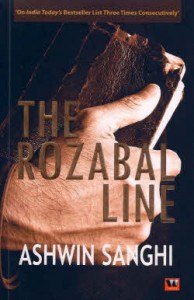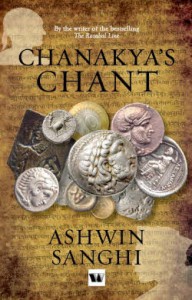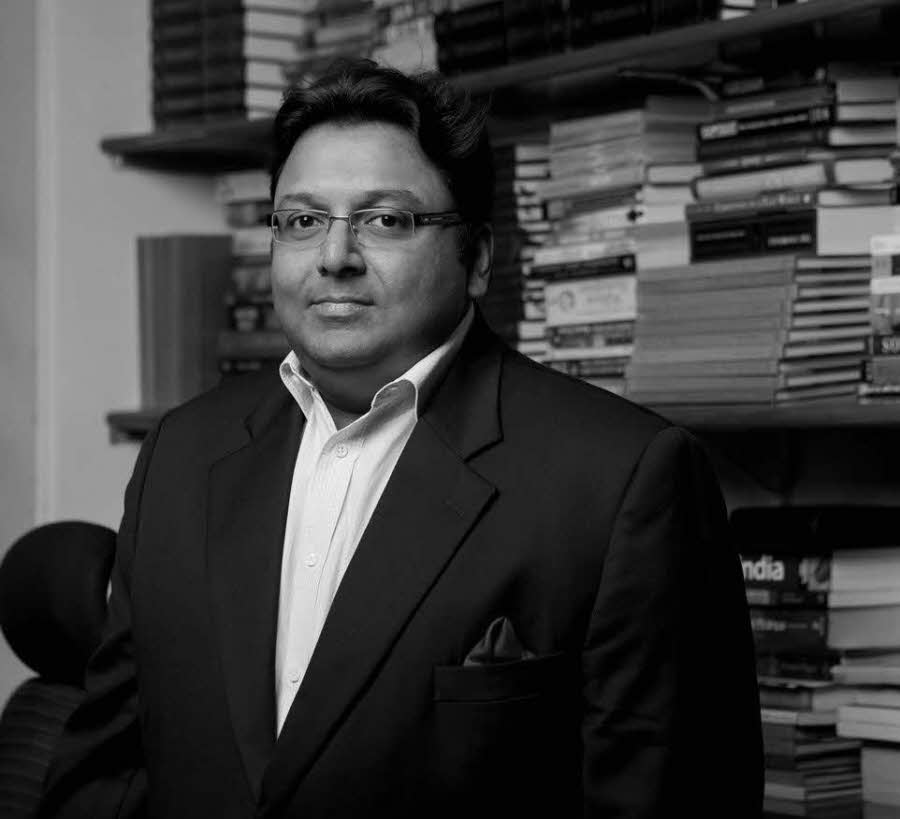Ashwin Sanghi is the bestselling author of ‘The Rozabal Line’ and ‘Chanakya’s Chant’. He writes extensively on history, religion and politics. ‘The Rozabal Line’, his first novel, was completed in 2007. The book was self-published in the U.S. in 2007 under his pen name, “Shawn Haigins”. “Shawn Haigins” is a pseudonym and in fact, is an anagram of the author’s real name. A revised edition of this book was later published by Tata-Westland Ltd. & Tranquebar Press in 2008. Ashwin’s second novel, “Chanakya’s Chant”, a historical political thriller was released by Westland in January 2011.
Today, we know Ashwin Sanghi as a widely-read author of two bestsellers. But, how did it all begin? What prompted you to undertake the writer’s journey?
When I was studying at the Cathedral & John Connon School in Mumbai, I contributed a few articles to the school newspaper but they were not very enthusiastically received. When I went to Yale for my Masters’ I wrote a column for the school’s monthly magazine and several people told me that they enjoyed my casual yet brisk style of writing. I returned to India and immersed myself in my family’s business affairs and my urge to write manifested itself in terms of a few uneventful business-related articles in scattered journals. To a certain extent, my business persona seemed to be dictating what I could or couldn’t write. I did not realise then that I was killing my passion by writing business-related articles—especially when Writing was my route to creative expression and I needed to write about the things that interested me. In 2004, I was going through a difficult patch in my life and my wife suggested that I try writing a few pages during a short holiday. At the end of the five-day break, I had written over 10,000 words and since then, there has been no looking back.
What made you choose historical fiction?
It was Edmund Burke who said, “Those who don’t know history are destined to repeat it.” I find that when I observe current events around me, I instinctively correlate these with events that happened in the past. When I read about modern-day conflicts between Islam and the western world, I can’t help thinking of the religious Crusades that were fought for most of the 300 years following the 11th century. When I read about the Nithari serial killings, I begin to mull over the terror that Jack the Ripper caused in England in 1888. When I watch the IPL allegations on TV and the consequent damage that it may have done to the reputation of cricket, I think about the Black Sox scandal that almost ruined baseball in 1919. When I hear about scams like those of the CWG or Telecom, I correlate them to the Railroad Bubble. History inevitably repeats itself, one simply needs to observe the patterns. This pattern is what interests me, not the history in itself and this is what is central to my fiction.
When many novels published today are set in the world as we see it today, your novels travel back to a time that we did not live in. How challenging is it to weave history and fiction?
There indeed exists a segment of readers who wish to read fiction that resembles reality. What I do is to simply fill in the blanks. For example the assassination of JFK is a historical fact but who was actually behind JFK’s death is something that is open to speculation. It is in those “grey areas” that we fiction writers have the greatest flexibility to weave a story. It is this flexibility that gives me the creative wiggle room to spin my yarns! History, mythology, conspiracy, mystery and suspense are the nucleotides of my writer’s DNA. I cannot imagine myself writing outside this comfort zone.
How did your first book The Rozabal Line happen? What inspired the storyline of the book?
In 1999, I read Holy Blood Holy Grail by Michael Baigent, Richard Leigh, and Henry Lincoln. A couple of years later, I read Holger Kersten’s Jesus Lived in India and was fascinated by the idea that Jesus could have been inspired by Buddhism and that he may have drawn much of his spiritual learning from India. I began to wonder whether I could marry the two theories i.e. he survived the crucifixion and travelled to India and that he left behind a bloodline. I spent the next two years reading each and every book that I could acquire on topics that I wanted to explore viz. the possibility of Jesus having spent his missing years as a youth studying in India, the theory that Jesus did not die on the cross and that he was whisked away to safety, and the notion that Jesus travelled to India to reunite with the lost tribes of Israel who had settled in Kashmir. In all, I read around 40 books during this time besides scouring the Internet for any information that I could possibly find. I started writing The Rozabal Line in 2005 and finished it 18 months later.
in India and was fascinated by the idea that Jesus could have been inspired by Buddhism and that he may have drawn much of his spiritual learning from India. I began to wonder whether I could marry the two theories i.e. he survived the crucifixion and travelled to India and that he left behind a bloodline. I spent the next two years reading each and every book that I could acquire on topics that I wanted to explore viz. the possibility of Jesus having spent his missing years as a youth studying in India, the theory that Jesus did not die on the cross and that he was whisked away to safety, and the notion that Jesus travelled to India to reunite with the lost tribes of Israel who had settled in Kashmir. In all, I read around 40 books during this time besides scouring the Internet for any information that I could possibly find. I started writing The Rozabal Line in 2005 and finished it 18 months later.
Religion is a sensitive topic to write on. How did you handle the criticism that might have come your way when you published The Rozabal Line?
The Rozabal shrine contains two graves. The most recent is of Syed Naseerudin, a Medieval saint whose life is fairly well documented. However, the earlier inhabitant—Yuz Asaf—was buried there in 112 AD and this was 500 years before the advent of Islam. Yuz Asaf was a charismatic preacher who arrived in Kashmir from Israel and his name means “the healer” or “the shepherd”. So is Rozabal a Christian place of worship or a Muslim one? Surprisingly, both Christians and Muslims dismiss the idea as blasphemy. Both religions say Jesus Christ was taken by God into heaven, while some Islamic and Christian sects say there will be a “second coming” of Jesus Christ. But the story of the tomb in itself was not where my interest lay. I wanted to explore Buddhist influence on early Christianity; I wanted to tie in the lost or missing years of Jesus into this story; I wanted to examine the ancient connections between India and the Lost Tribes of Israel; I wanted to explore the worship of the sacred feminine across cultures. This was a book that I simply had to write. I genuinely believe that those who have read this novel understand that the aim was noble—to unite via the exploration of common origins. As regards controversy, there are those who can find something controversial in Mary Had a Little Lamb! I’ve decided to ignore that fringe.
And the second novel, Chanakya’s Chant. Was the idea a sudden realisation of sorts or were you planning it for a while?
It was the Indian General Elections of 2009 that inspired me. The UPA had won the elections but cabinet formation was held up due to jockeying for posts by alliance members. I thought to myself: was politics always this messy? Chanakya’s Chant was simply the answer to that fundamental question.
In Chanakya’s Chant, the narrative travels back and forth in time. Writers tend to dwell in the world they create when they are in the process of writing. How did you approach this whole idea of dwelling in two different times and weaving them together and implement it?
I am often asked this question. The honest truth is that I didn’t give it too much thought. The three most important elements of my novels are plot, plot and plot. I spend hours developing and fleshing out the plot. Plot drives my characters. Plot drives pretty much the entire book. Once I have a detailed plot outline for the entire story, I know what backdrops, elements, character traits, twists and historical or mythological facts will be needed to propel the story forward. I don’t need to relive the world that my characters inhabit. I simply create the world that my plot demands.
How much of a role has research played in writing your books? What are some of the materials you looked into for The Rozabal Line and Chanakya’s Chant?
The research involved in writing The Rozabal Line was much more exhaustive than that of Chanakya’s Chant. This was simply due to the fact that one had to tread very carefully when writing fiction that touched upon someone’s faith. I had less concerns when it came to writing about the political confabulations of Chanakya.
With The Rozabal Line, I found that there was a wealth of information that I could dip into. Some of this information was available in excellent books that had covered various issues such as the Jesus in India hypothesis, the historical Jesus, and the interplay of mythologies and religious beliefs in the evolution of the character of Jesus. Books such as Jesus Lived in India by Holger Kersten, Jesus in Kashmir: The Lost Tomb by Suzanne Olsson, The Fifth Gospel by Fida Hassnain, The Unknown Life of Jesus by Nicolas Notovich and The Lost Years of Jesus by Elizabeth Clare Prophet were very important in building the framework of the story. Other books such as The Christ Conspiracy: The Greatest Story Ever Sold by S. Acharya and The World’s Sixteen Crucified Saviours by Kersey Graves were important from the angle of building the “alternative hypothesis” around the canonical Jesus. I spent most of 2003 and 2004 reading every book that I could lay my hands on (around 40+). These books are listed at the back of my novel. I only started writing in 2005 after I had completed reading these books.
With Chanakya’s Chant, the research was at two levels because, as you know, there are two parallel stories in this book. The first one traces the rise of  Chanakya 2300 years ago and ends with him having succeeded in installing Chandragupta Maurya to the throne. The second traces the life of Gangasagar Mishra, a Brahmin teacher from Uttar Pradesh who makes it his life’s purpose to turn a girl from a slum into the country’s Prime Minister. The ancient story required historical reading, including the Arthashastra as well as several other books penned on Chanakya. I also read an English translation of the Mudrarakshasa—a historical play in Sanskrit by Vishakhadatta who lived in the 4th century. The modern-day story simply involved lots of newspaper reading. The drama of politics is enacted before us each day in the front pages… one doesn’t need to stray any further!
Chanakya 2300 years ago and ends with him having succeeded in installing Chandragupta Maurya to the throne. The second traces the life of Gangasagar Mishra, a Brahmin teacher from Uttar Pradesh who makes it his life’s purpose to turn a girl from a slum into the country’s Prime Minister. The ancient story required historical reading, including the Arthashastra as well as several other books penned on Chanakya. I also read an English translation of the Mudrarakshasa—a historical play in Sanskrit by Vishakhadatta who lived in the 4th century. The modern-day story simply involved lots of newspaper reading. The drama of politics is enacted before us each day in the front pages… one doesn’t need to stray any further!
Chanakya’s Chant recently won the Crossword Best Book Award in the popular category. Did you expect it? What do awards mean to you?
To quote a famous Hollywood actor: “I’ll take any trophy. I don’t care what it says on it.” Jokes apart, although I knew that Chanakya’s Chant had touched a chord with readers, I had no idea that it would lead to the Crossword Popular Choice Award. I have been overwhelmed with the sort of response that I have received forChanakya’s Chant.
Speaking of your writing endeavours, will you attempt non-fiction some time? What would such a work focus on?
Seven years ago, I had started writing a work of non-fiction that traces the roots of Indian business, but it has remained an incomplete manuscript. I am currently in the process of reviewing it and developing it as the backdrop for my third work of fiction. At present, fiction is what allows me to escape from the humdrum of my otherwise boring and uneventful life. I do not see myself straying away from fiction for a while.
Lastly, what is the next one coming from Ashwin Sanghi? We would like a teaser!
As mentioned earlier, I am currently working on a third novel, as yet untitled. It straddles the past and the present. With my first novel, I explored a theological riddle. My second novel focused on politics. My next novel shall be about business. It’s business as usual!
